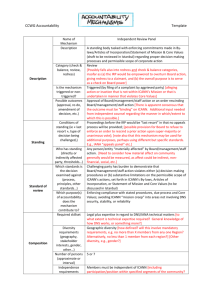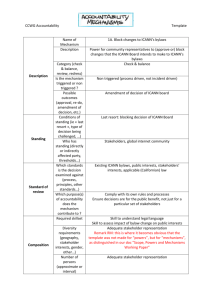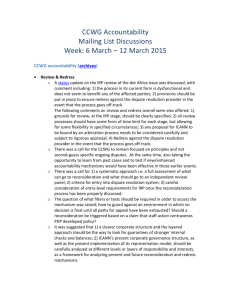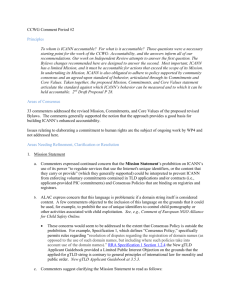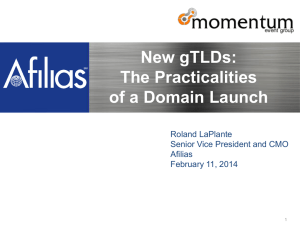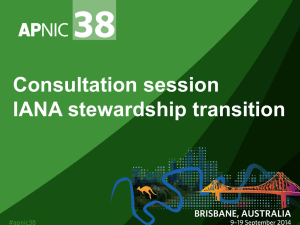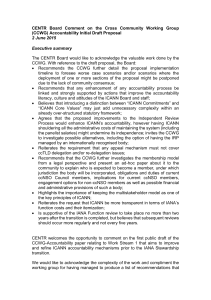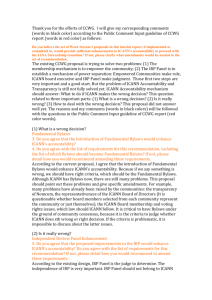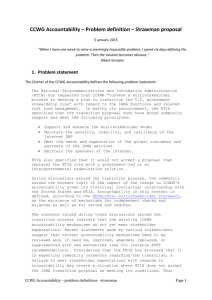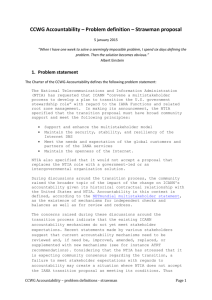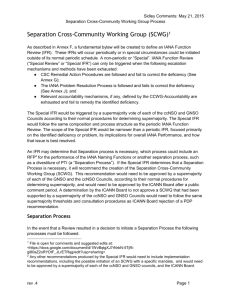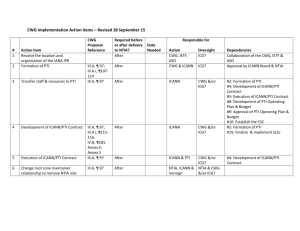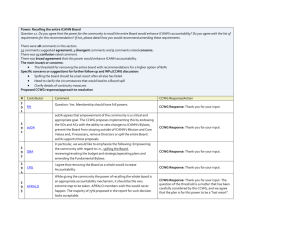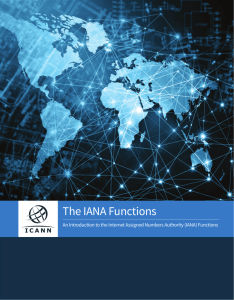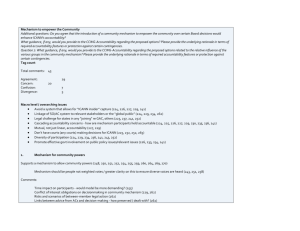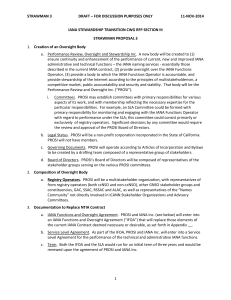Accountability Mechanism Template Supervisory Board
advertisement
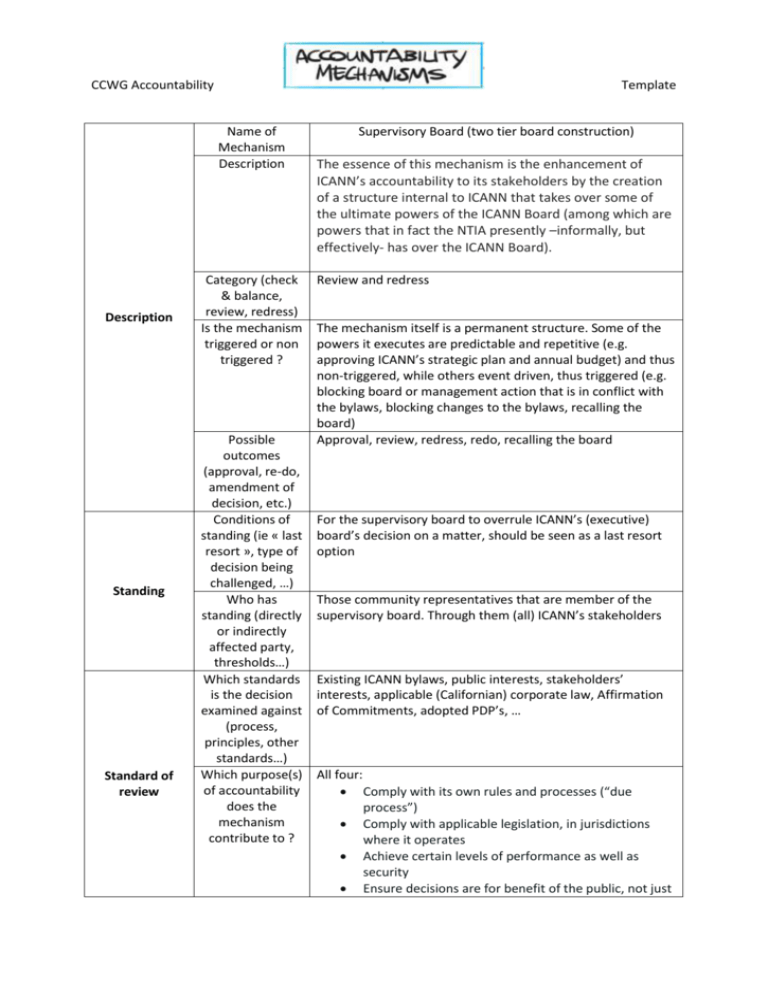
CCWG Accountability Template Name of Mechanism Description Description Standing Standard of review Category (check & balance, review, redress) Is the mechanism triggered or non triggered ? Possible outcomes (approval, re-do, amendment of decision, etc.) Conditions of standing (ie « last resort », type of decision being challenged, …) Who has standing (directly or indirectly affected party, thresholds…) Which standards is the decision examined against (process, principles, other standards…) Which purpose(s) of accountability does the mechanism contribute to ? Supervisory Board (two tier board construction) The essence of this mechanism is the enhancement of ICANN’s accountability to its stakeholders by the creation of a structure internal to ICANN that takes over some of the ultimate powers of the ICANN Board (among which are powers that in fact the NTIA presently –informally, but effectively- has over the ICANN Board). Review and redress The mechanism itself is a permanent structure. Some of the powers it executes are predictable and repetitive (e.g. approving ICANN’s strategic plan and annual budget) and thus non-triggered, while others event driven, thus triggered (e.g. blocking board or management action that is in conflict with the bylaws, blocking changes to the bylaws, recalling the board) Approval, review, redress, redo, recalling the board For the supervisory board to overrule ICANN’s (executive) board’s decision on a matter, should be seen as a last resort option Those community representatives that are member of the supervisory board. Through them (all) ICANN’s stakeholders Existing ICANN bylaws, public interests, stakeholders’ interests, applicable (Californian) corporate law, Affirmation of Commitments, adopted PDP’s, … All four: Comply with its own rules and processes (“due process”) Comply with applicable legislation, in jurisdictions where it operates Achieve certain levels of performance as well as security Ensure decisions are for benefit of the public, not just CCWG Accountability Template for a particular set of stakeholders Required skillset Composition Diversity requirements (geography, stakeholder interests, gender, other…) Number of persons (approximate or interval) Independence requirements Election / appointment by whom ? Recall or other accountability mechanism Is the decision mandated or based on personal assessment Decision making Vision, strategy, leadership Analytical, social skills, networking C-level integral management in an international, multi-stakeholder, multi-cultural environment Representation, sensitivity All stakeholders (direct and indirect) should be represented: SO’s, AC’s, IETF, NRO, ISOC, IAB. This will probably already ensure gender and geographical diversity See above The persons involved in making or validating a decision of the supervisory board, apart from the obvious interests as a member of the stakeholder group they represent, do not have any other material relationship, transaction or professional aspiration with ICANN itself which may affect their judgment. Each member of the supervisory board is appointed (by election) by his/her stakeholder group/constituency. Easiest would be to appoint the (already elected) chairs of those groups/constituencies Each member of the supervisory board can –during his/her term- be recalled (by majority vote) or at the end of his/her term could not be reelected by his/her stakeholder group/constituency. A member of the supervisory board cannot be recalled by the other members of the supervisory board. There are two options: 1. The community representatives have to get back to their constituencies and get their (consensus or rough consensus) approval to use the specific power; 2. The community representatives have the mandate from their respective constituencies to take a position based on their personal assessment of the bylaw amendment on the public interests/stakeholders’ interests (NOT their personal interests) In most situations, for most powers that the supervisory board has, option 1 will not be workable: it will take too long with the risk of failing altogether. However, for the decision to recall the (whole) board, option 1 should be considered. For the “nuclear option” (if we are having one), transitioning the IANA function away from ICANN, option 1 is an obligation. CCWG Accountability Template Decision made by Vote. Consensus introduces (or reinforces) the risk of capture: consensus or if a particular stakeholder group has convinced the ICANN vote ? board to e.g. make an amendment to the bylaws, this same stakeholder group’s representative in the supervisory board can then prevent the community from blocking that amendment Majority Depending on the decision to take/power to execute: simple threshold (if majority or supermajority. applicable) (Option: a condition could be that if there is no super majority, an independent review has to precede adoption of a simple majority decision) Cost The members of the supervisory board are volunteers from requirements their respective constituencies. They receive no remuneration, but travel and lodging costs for meeting purposes are covered by ICANN Accessibility Timeframe To be implemented before IANA stewardship transition requirements Language As general requirements Potential means Amendments to ICANN’s bylaws that incorporate an to implement supervisory board in ICANN’s corporate governance Implementation structure and provides it with the required powers; Elected representatives from stakeholder groups to serve on supervisory board Notes from the author: This template is completed for a two-tier board construction,l introducing a supervisory board. Large parts of the text inserted in the template will also be relevant for a membership structure, a delegates structure, a permanent CCWG or any other stakeholders’ representing structure that can overrule the ICANN board on certain matters. Recalling the board or part thereof: recalling individual board members or a group is probably not a good idea. Individual members might feel themselves a target and be afraid to take a position that differs from the majority, one risks stimulating the board members to be risk averse. Recalling the whole board and reappointing members that are not to blame for the recall, is probably better The “nuclear option”: more and more I doubt if this is necessary and if it is workable. If the board can be recalled and is, the impact of that is comparable with transferring IANA: it is now possible to change everything that is not working. Transferring only IANA functions might have (very) limited impact if the policy role remains with ICANN and the output of that policy role is still inputted in the IANA function. Moreover, if ever ICANN performs so badly that even replacing the board doesn’t help, it is extremely likely that it is not the IANA that is not working well, but the policy function. So, the “nuclear option” might very well be exactly that and leave no winners, but only losers. When considering this, we should bear in mind that presently, the NTIA can transfer the IANA functions. It cannot recall the board. If it could choose between the two, I suspect it would choose for the power to recall the board as it is both executable and effective. Transferring the IANA functions is neither. It took 16 years to build ICANN into what it presently is, how long would it take us to build a trusted, better, more accountable, more transparent alternative? Roelof Meijer
